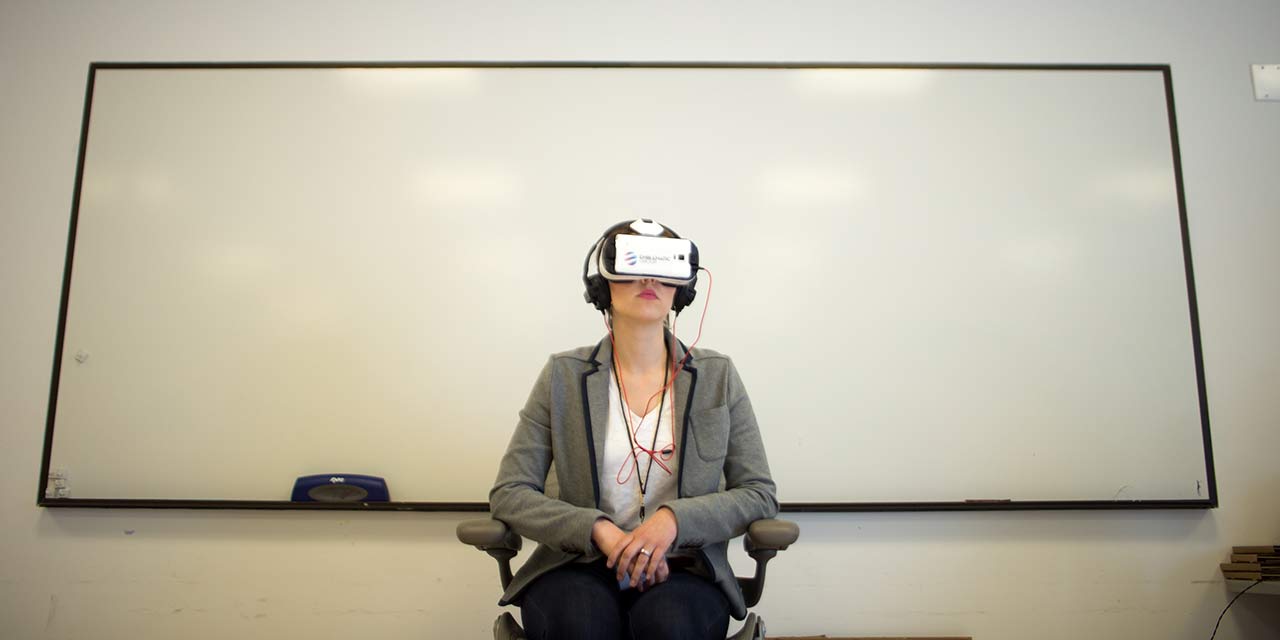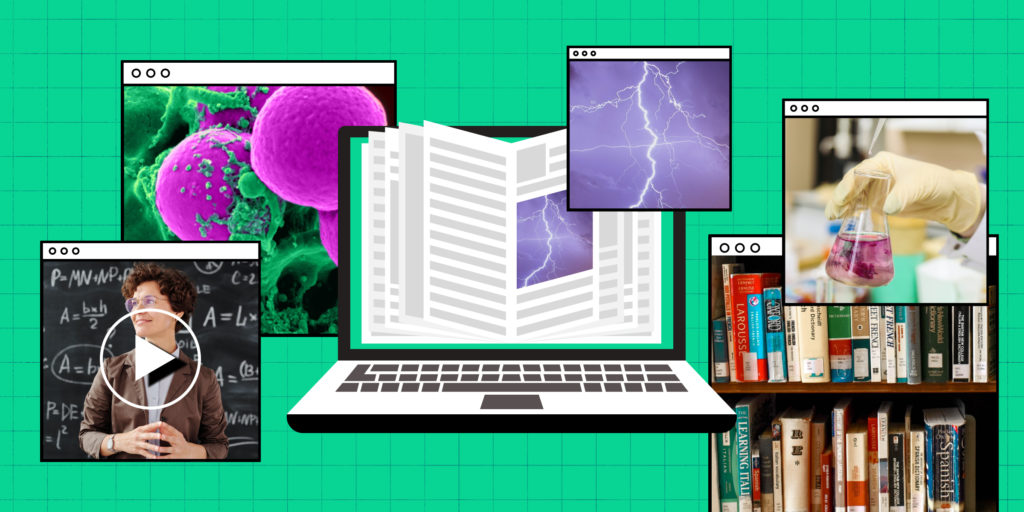When you’re making predictions about technology—even education technology—a great place to start is science fiction. Authors don’t necessarily have any second sight into what’s beyond the horizon, but engineers and designers invariably end up using the work of authors as inspiration for creating the future. 1
One of the most foundational authors in science fiction, Isaac Asimov, was also professor of biochemistry at Boston University. In a 1983 article for the Toronto Star, Asimov wrote that one of the main differences between 1983 and the world of 2019 would be near-universal “computerization.”
He writes, with uncanny accuracy: “The mobile computerized object, or robot, is already flooding into industry and will, in the course of the next generation, penetrate the home… There is bound to be resistance to the march of the computers, but barring a successful Luddite revolution, which does not seem in the cards, the march will continue.” 2
But predictions of future technology fail when they suggest that technology replaces, rather than reforms and reorients, human relationships. So, when it comes to education technology in 2019, Asimov sees some of the demographic changes—but little of the practical, human adaptation of technology for the classroom.
While “the next generation will be one of difficult transition as untrained millions find themselves helpless to do the jobs that most need doing,” he only saw classroom education as a supplement to learning online, rather than the basic keystone of the learning relationship: “A good schoolteacher can do no better than to inspire curiosity which an interested student can then satisfy at home at the console of his computer outlet.”
Massive online open courses (MOOCs) are one aspect of education technology that arguably fulfill his prediction that there will be an “opportunity finally for every youngster, and indeed, every person, to learn what he or she wants to learn, in his or her own time, at his or her own speed.” But in-person classes are still valuable, and “mobile computerized object” technology has irreversibly changed the way that instructors and students interact.
With this in mind, our technology in education 2019 predictions are less about exactly what emerging technologies will be—most of them exist already—but how they will be applied. Here are our top five education technology predictions for the coming 12 months; no time-travel required.
Learn how to make teaching fun and effective
Subscribe to Top Hat’s weekly blog recap
Technology in Education 2019: Augmented reality

Photograph: Knight Center for Journalism, CC BY 2.0
Let’s start with the most sci-fi prediction of all: augmented reality (AR). What should we look forward to in education technology for this much-hyped and buzzworthy technology that always appears to be on the point of breaking through?
Last year, the startup Magic Leap released a prototype of their mass-market AR glasses, which was received warmly if not enthusiastically.3 According to Adi Robertson of Vox, augmented reality is established in industrial and medicine contexts, but has yet to really hit wider mainstream appeal—in fact, many AR hardware companies are scaling down their plans for 2019.
Students in a learning environment for medicine and manufacturing-focused skill sets can expect to see AR being increasingly used in context for training, as a learning technology. Some examples of this are AR in use in surgery planning and practice, as described by the Harvard Business Review4, and Lampix, an interactive and collaborative tool that changes any flat surface into a multimedia whiteboard that can visualize data and workflow processes.5
However, in other fields AR is an edtech solution looking for a problem, as Top Hat CEO Mike Silagadze explains: “AR is not the disruptor it’s being made out to be. In the higher education sector, AR applications will be the next MOOCs: the initially vaunted technology expected to shake the American college system to its foundations that ended up as a quaint teaching aid for vocational training.”6 For our technology in education 2019 predictions, there are more important things to consider.
Technology in Education 2019: 5G
On the other hand one thing we do know is coming over the course of 2019 is the U.S.-wide rollout of 5G technology.7 This is great news if your campus Wi-Fi network is starting to groan under the strain of hundreds of connected phones, tablets, laptops, and now (thanks to the Internet of Things) watches, vending machines, toasters and so on.
5G, which is in the early stages of implementation, is a new mobile spectrum meant to replace 4G/LTE, and it has two aims relevant to technology in education: it will be more robust for connecting large numbers of devices, and work equally well inside and outside of buildings. It’s about 40 times as fast as the average home Wi-Fi network; in fact, as of 2019, you can now even buy home routers that use 5G instead of Wi-Fi.8
Some companies are looking at ways of taking fuller advantage of the speed and bandwidth to investigate new technological applications in the education sector—Verizon, for instance, has set up a 5G EdTech Challenge to “to solve for challenges including lack of student engagement, lack of teacher’s STEM expertise and the need for more immersive personalized support for students with special needs.”9
But for now, this increase in bandwidth and connectivity will open the door to more reliable use of existing education technology, and fewer spinning beach balls waiting for your learning management system to update.
Technology in Education 2019: Generation Z in class

While bandwidth increases, bandwidth-connected students increase too. If you haven’t already started seeing the generation after Millennials in class—Generation Z—2019 is the year they’ll start appearing in earnest.
Generation Z has been steeped in technology for their entire lives, which have only taken place within the 21st century. Why should they expect higher education to be any different? As education expert Philip Preville explains, the postsecondary post-Millennial generation’s social lives are almost entirely online; they expect to have the content they need on demand (not out of entitlement, but because that’s how it’s always been for them); and they prefer watching videos over reading text.10
As one Generation Z graduate, Christen Palange, tells The Chronicle of Higher Education, college is a place where new students can take responsibility for their technology use and put it to their advantage. Furthermore, she adds: “I don’t know of any job that my class will go into where we won’t be using a computer and have access to the internet.”11
For teachers and for universities, this means a shift in technology usage to meet the new generational cohort where they are. For instance, instead of holding regular in-person office hours, an educator could make him- or herself available on instant messaging apps such as WhatsApp or Signal. And group projects could take advantage of online collaboration tools such as Google Docs or Slack—the same ones they will be using in their career. Yes, education technology can be that simple.
Technology in Education 2019: Inclusion
Technology can be either inclusive or exclusive. 2019 will be a year where increasingly large numbers of higher education institutions will have to work to meet accessibility guidelines—and to make sure that their students can reap the benefits that technology in education can bring.
Changes are already happening at simple levels. In November 2018, a Brooklyn-based man filed a lawsuit under the Americans With Disabilities Act against 50 colleges saying that their sites were not accessible to prospective students who need screen readers to navigate the web.
Peter Blanck, professor of law at Syracuse University, spoke to Inside Higher Ed about the lawsuits. “It’s beside the point whether there are 50 or 1,000 lawsuits,” he said. “These cases are reflective of a larger systemic problem—that there is a lack of a strong commitment by many institutions to try to be as inclusive as possible.”12
The misfit between technology and teaching goes both ways as well—when a learner brings or asks for adaptive technologies in order to access education, his or her needs are often not being met. The EDUCAUSE Center for Analysis and Research Study of Undergraduate Students and Information Technology 2018 found the following:
“A plurality of students who self-identify as having a physical and/or learning disability requiring accessible or adaptive technologies for their coursework rated their institution’s awareness of their needs as poor. According to students, larger and DR [doctorate-granting] public institutions tend to have poorer awareness of disabled students’ needs than do smaller and AA [associate of arts granting] institutions.
In addition to institutional limitations, students’ fears of being stigmatized or penalized for disclosing their disabilities and engaging disability services to receive the aid they need may be contributing to low rates of awareness.”
There are consequences to this. A study by The Hechinger Report found that the majority of students with disabilities don’t get a college degree—in fact, only a third of students who enroll in a four-year course graduate within eight years.13 But as well as personalized education, study skill training, and using an adapted curriculum, many organizations are finding a helpful way to bridge the gap is through flipped classrooms, blended learning and ultimately, online courses.
For students whose disabilities prevent them from physically attending a full course load, a more seamless option would be to pursue or complete a degree through an established online program. But some are finding that these are being considered inferior to face-to-face courses.
In an article for Inside Higher Ed, Brittany R. Collins argues that equity through online education is a rights issue. “Is it reasonable for students whose disabilities impede campus attendance to request technological accommodations that would catalyze their remote participation in an otherwise in-person program?” she asks. “Could these alterations be framed differently—not as an institutional programmatic restructuring, but as a case-by-case option, since the technology already exists?”14
It’s likely that in 2019, employers and higher education institutions alike will be increasingly asked to offer equity between in-person and online-only courses, and adapt any online courses to be pedagogically equivalent.
Technology in Education 2019: Digital security and ransomware
As education technology becomes fully realized and devices become more widespread, there are more and more ways in which data and important information can leak or be held to ransom. According to EDUCAUSE’s 2018 white paper, Why Cybersecurity Matters: and What Registrars, Enrollment Managers and Higher Education Should Do About It15, the biggest mistake an individual professor could make is to assume that digital security in education technology is solely the purview of the IT department.
The main reason that everybody who uses education technology in 2019 should be aware of security holes is the increasing threat of ransomware—because it targets individuals as a way of crippling institutions.
Ransomware is when malicious code causes you to lose access to important data and files but offers to restore them for a fee, often in Bitcoin (the transfer of which can be made untraceable). The EDUCAUSE white paper adds that 91 percent of cyberattacks started with a malicious e-mail, and that healthcare, higher education and government organizations are most at risk.
Ransomware has hit academia before. In 2016, the University of Calgary announced that they had paid a ransom of $16,000 to retrieve “critical research data” after such an attack. “We are a research institution, we are conducting world-class research daily and we don’t know what we don’t know in terms of who’s been impacted. The last thing we want to do is lose someone’s life’s work,” said Linda Dalgetty, the university’s vice-president of finance.16
The best thing that an individual can do to prevent these risks is by keeping regular backups of important work, such as research17, to avoid clicking on even-mildly suspicious e-mails, and to be scrupulous about upgrading and keeping devices clean of unknown software and hardware. (There have even been rare reports of students themselves installing malicious software through keyloggers installed on USB keys.18)
Technology in education 2019: The conclusion
Looking back to Asimov, his collection of short stories I, Robot was among the first examples of literature that humanized and assigned personalities to robots and to technology. Barring Alexa and Siri, we’re not there yet in 2019; the only personalities affixed to our “mobile computerized robots” are our own. Responsible, relationship-based usage of the technology already in our hands is the best way we can achieve a future we can all be happy with.
References
- Maddox, T. (2017, September 22). Tech leaders share how Star Trek inspired them to pursue a career in technology. Retrieved from https://www.techrepublic.com/article/tech-leaders-share-how-star-trek-inspired-them-to-pursue-a-career-in-technology/
- Asimov, I. (2018, December 27). 35 years ago, Isaac Asimov was asked by the Star to predict the world of 2019. Here is what he wrote. Retrieved from https://www.thestar.com/news/world/2018/12/27/35-years-ago-isaac-asimov-was-asked-by-the-star-to-predict-the-world-of-2019-here-is-what-he-wrote.html
- Robertson, A. (2018, August 08). I tried Magic Leap and saw a flawed glimpse of mixed reality’s amazing potential. Retrieved from https://www.theverge.com/2018/8/8/17662040/magic-leap-one-creator-edition-preview-mixed-reality-glasses-launch
- Murthi, S. (2018, April 05). How Augmented Reality Will Make Surgery Safer. Retrieved from https://hbr.org/2018/03/how-augmented-reality-will-make-surgery-safer
- Hendrix, J. (2018, December 27). 4 Augmented and Virtual Reality Projects That Point to the Future of Education – EdSurge News. Retrieved from https://www.edsurge.com/news/2018-01-03-4-augmented-and-virtual-reality-projects-that-point-to-the-future-of-education
- Silagadze, M. (2018, January 16). Virtual And Augmented Reality In College Classrooms: More Hype Than Help. Retrieved from https://www.forbes.com/sites/forbestechcouncil/2018/01/16/virtual-and-augmented-reality-in-college-classrooms-more-hype-than-help/
- Zimmerman, E. (2018, September 26). 5G Set to Open New Doors for Education Technology in Higher Ed. Retrieved from https://edtechmagazine.com/higher/article/2018/09/5g-set-open-new-doors-education-technology-higher-ed
- Dent, S. (2019, January 04). D-Link’s latest router uses 5G for super fast home broadband. Retrieved from https://www.engadget.com/2019/01/04/d-link-dwr-2010-5g-router/
- Verizon Innovative Learning launches first ever 5G EdTech Challenge calling for solutions to challenges in under-resourced classrooms. (2018, September 18). Retrieved from https://www.verizon.com/about/news/verizon-innovative-learning-launches-first-ever-5g-edtech-challenge-calling-solutions
- Preville, P. (2018, October 16). How to Teach Generation Z in the Classroom. Retrieved from https://tophat.com/blog/generation-z-teach-classroom/
- Gose, B. (2017, September 17). Gen Z Changes the Debate About Devices in the Classroom. Retrieved from https://www.chronicle.com/article/Gen-Z-Changes-the-Debate-About/241163
- Mackenzie, L. (2018, December 10). 50 Colleges Hit With ADA Lawsuits. Retrieved from http://www.insidehighered.com/news/2018/12/10/fifty-colleges-sued-barrage-ada-lawsuits-over-web-accessibility
- Mader, J., & Butrymowicz, S. (2017, November 22). The vast majority of students with disabilities don’t get a college degree. Retrieved from https://hechingerreport.org/vast-majority-students-disabilities-dont-get-college-degree//
- Collins, B. R. (2018, August 29). Online Education Is a Disability Rights Issue. Retrieved from https://www.insidehighered.com/digital-learning/views/2018/08/29/online-education-disability-rights-issue-lets-treat-it-way-opinion
- Why Cybersecurity Matters: and What Registrars, Enrollment Managers and Higher Education Should Do About It. [White Paper]. (October 2018). Retrieved from https://library.educause.edu/~/media/files/library/2018/10/cyberseconestop.pdf
- University of Calgary pays ransom after attack on computer systems. (2018, May 16). Retrieved from https://www.theglobeandmail.com/news/national/university-of-calgary-pays-ransom-after-attack-on-computer-systems/article30346543/
- Backing Up Your Data. (n.d.). Retrieved from https://www.rit.edu/security/content/backing-your-data
- Himmelsbach, V. (2018, November 15). Keylogging is the Latest Way of Cheating in College. Retrieved from https://tophat.com/blog/cheating-in-college-keyloggers-security/
Related stories
Ed tech expert Phil Hill’s technology trends in higher education predictions
Pros and cons of technology in the classroom
Related pages
Learn why Top Hat is the best learning management system



